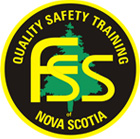Lockout Procedures for Machines
Hazards Identified
Crushing injuries, entanglement, electrical contact caught in pinch points
Hazard-Specific Personal Protective Equipment
Hard hat, safety boots, gloves, eye protection
Hazard-Specific Training
Confined space, lookout procedures
Safe Work Practice
This procedure is to be followed for lock out and tagging equipment undergoing such work where injury or death could result from unexpected motion, or contact with energized circuits.
- In the event that the unit must be left shut down for repair or further work, a different system must be used to secure the machinery. Disable the equipment with a method approved by your employer (ie) (alternative lock system). Always take your personal lock when you leave.
- When working within the range of energized circuits, pinch points, points of operation, rotating or oscillating parts or where operation is not required, the machinery must be completely de-energized, lock out and tagged. Stored energy must be neutralized. This includes the release of hydraulic or pneumatic pressure and blocking or releasing any spring-driven or gravity-operated mechanism.
- When working on the hydraulic system of hydraulic equipment, the equipment must be “landed” on pipe stands or similar supports to prevent accidental motion resulting from the loss of hydraulic pressure.
- Equipment using a plugged 110 volt power supply will be considered locked out if the plug is disconnected, and left untagged, with the end clearly in view.
- Personnel must be trained to perform lockout/tagout procedures and will have access to lockout tags and lockout devices. Only one key or combination shall be available to supervisory personnel to be used in emergency situations.
CAUTION: Power sources may be hydraulic but controls are electric, or other combinations. Both the source AND controls need or may need to be locked out.
Regulations, Standards and References
Occupational Safety General Regulations
Supervisor’s Responsibility
It shall be the responsibility of all supervisors to:
- Instruct workers in the operation of this procedure.
- Periodically follow-up to ensure compliance.
- Have a company lock or shift change overlap.
- The supervisor may delegate the instruction of employees and follow-up compliance with this procedure to the Foreman, worker-in charge or the worker.
- If extraordinary conditions required operation of equipment which is lock out, this is permissible only be direct order of the supervisor who must ensure that it can be done safely before removing the lockout. Ensure communication and complete inspection is done.
- The supervisor must ensure that the equipment is locked out again before work recommences.
Worker’s Responsibility
- Understand the equipment; be aware it’s potential hazards. If uncertain, contact the supervisor before proceeding.
- All affected workers must be notified that a lock out and tag out system is going to be utilized and the reason for it.
- If more than one worker is assigned to a task, each will be responsible for placing his/her own lock and “DO NOT START” tag, so the controls cannot be operated. If controls are located that only one lock can be accommodated, a multiple lock out device must be used.
- On electrical equipment, where accidental starting would create a hazard, open the switch to shut off the power, apply a personal lock and a “DO NOT START” tag will be placed by the mechanic at the point where the circuit was de-energized. (Fuse pullers must be used when removing fuses). Box must then be locked to prevent reinstallation of fuses by qualified personnel.
Worker’s Responsibility Continued:
CAUTION: There may be more than one power source. If necessary, lock out the car lighting supply circuit as well as any other auxiliary source of power.
- Valves or other energy disconnecting means shall be operated so that the energy sources are isolated from the machinery. Where the potential for injury exits, stored energy in capacitors, and hydraulic, spring, or pneumatic pressure must also be dissipated or blocked prior to performing work in their vicinity.
- If a machine is locked out and it becomes necessary, recheck upon returning to make sure the machine is still locked out.
- If more than one shift is involved to complete the work, the relief worker should place his/her lock on the energy-isolating device prior to removal of the original lock and tag.
RETURN TO SERVICE
After all work is completed, the following procedure shall be used to restore the equipment to service.
- Only the employee who performed the lockout may remove the lock and tag. Then each person must personally remove his or her own lock.
- When the work is complete and the equipment is ready for testing, check the area for personnel, tools and other equipment before removing the Lock and Tag.
- Before leaving the area notify all other affected personnel that the work is complete.
Reviewed By:____________________ Date:________________________
